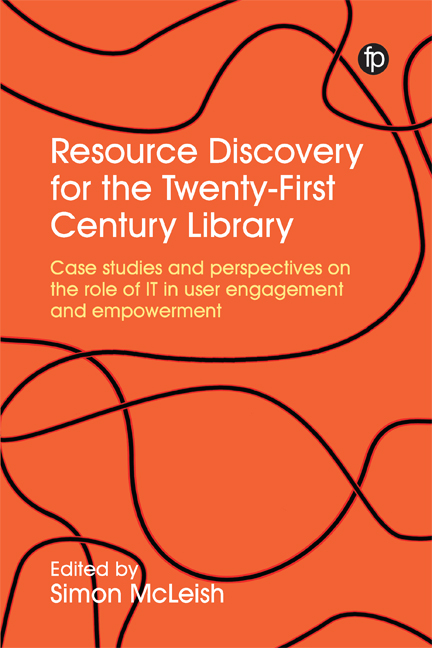Book contents
- Frontmatter
- Contents
- Figures and Tables
- Contributors
- Foreword: Library Discovery Directions
- 1 Introduction: Technology and Resource Discovery
- 2 Flipping the Catalogue: Taking Resource Discovery to the Next Level
- 3 Breaking the Record: Liberating Data into Knowledge at the National Library Board of Singapore
- 4 Case Study: Clearing Library Discovery-to-Access Pathways for IEEE Content
- 5 Case Study: Putting Discovery at the Heart of the Library Experience
- 6 Investigating Resource Discovery Needs at the University of Oxford
- 7 ‘Why Can’t you Just Use Google?’
- 8 Exposing Collections and Resources Effectively
- 9 Open Source Discovery using Blacklight at the University of Hull
- 10 A World of Curated Knowledge: Leveraging the Wider Semantic Web to Enhance Library Discovery
- 11 Cultural Discovery: Trends and Futures
- 12 Discovering the Future
- Editorial Afterword
- Index
1 - Introduction: Technology and Resource Discovery
Published online by Cambridge University Press: 23 July 2020
- Frontmatter
- Contents
- Figures and Tables
- Contributors
- Foreword: Library Discovery Directions
- 1 Introduction: Technology and Resource Discovery
- 2 Flipping the Catalogue: Taking Resource Discovery to the Next Level
- 3 Breaking the Record: Liberating Data into Knowledge at the National Library Board of Singapore
- 4 Case Study: Clearing Library Discovery-to-Access Pathways for IEEE Content
- 5 Case Study: Putting Discovery at the Heart of the Library Experience
- 6 Investigating Resource Discovery Needs at the University of Oxford
- 7 ‘Why Can’t you Just Use Google?’
- 8 Exposing Collections and Resources Effectively
- 9 Open Source Discovery using Blacklight at the University of Hull
- 10 A World of Curated Knowledge: Leveraging the Wider Semantic Web to Enhance Library Discovery
- 11 Cultural Discovery: Trends and Futures
- 12 Discovering the Future
- Editorial Afterword
- Index
Summary
This chapter provides a background to the remaining material in the book by giving a brief overview of the current discovery landscape, looking at:
the importance of resource discovery
interaction of technology and the needs of library users
how users approach discovery
how the rest of the chapters of the book fit together.
As this chapter covers in outline a lot of material, there are many references for further reading where more in-depth treatments can be found.
The importance of resource discovery
Discovery is fundamental to almost every human intellectual activity, as two events millennia apart show.
It is considered likely that the earliest forms of writing evolved from tokens used to record quantities ‘to document the affairs of an extensive bureaucratic network controlling labour, materials, and subsistence resources’ (Green, 1991). This can be understood as making it possible to find out information about the assets of the community. ‘Where is there grain stored?’ ‘How much livestock is there?’ These are discovery questions, and the tokens which became writing are mediators of that discovery. They make the answers to the questions portable: you no longer need to go to the wheat stores or sheep pens to find out the answer.
Over five millennia later, a new internet search engine was launched. Google rapidly became so culturally prevalent that its name is used as a common verb synonymous with ‘search’. According to the Oxford English Dictionary, the term was first used in this way on a mailing list in 1998, the same year in which Google was launched (OED, 2006) . Further history of the word is discussed by Philipson (2013) : within a few years, it appeared in popular TV programmes, in newspapers and books, and it is now used by virtually everybody with an internet connection. The modern online lifestyle would be impossible without discovery.
This book is concerned with discovery in an academic environment, something which has been part of the purpose of libraries and museums since they came into existence, a purpose which has gathered momentum in the electronic age. However, the book concentrates on discovery in the library; it does not discuss discovery for archives in detail.
- Type
- Chapter
- Information
- Publisher: FacetPrint publication year: 2020

